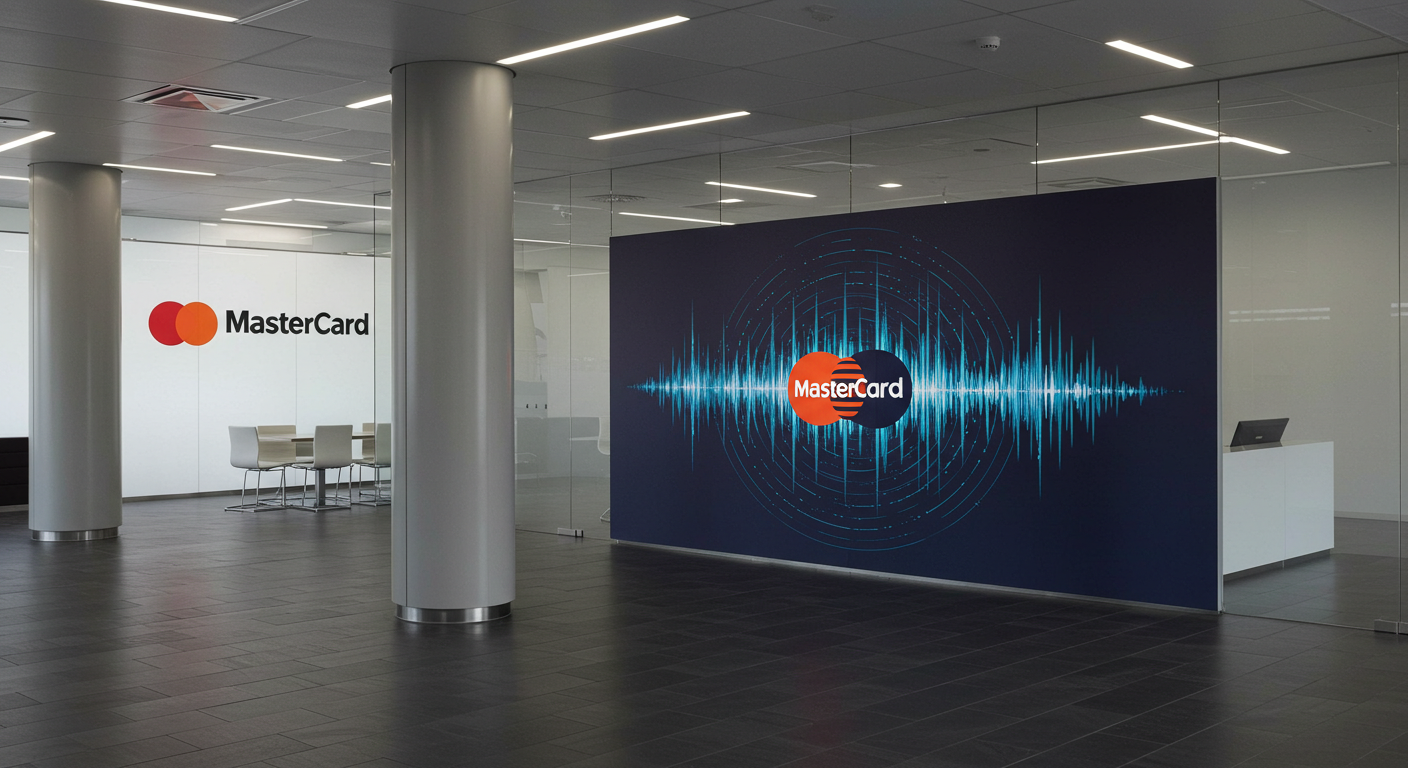 A modern office lobby featuring the Mastercard logo on a screen, with a soundwave graphic symbolizing the company's sonic identity
A modern office lobby featuring the Mastercard logo on a screen, with a soundwave graphic symbolizing the company's sonic identityIn 2019, the global payments giant Mastercard embarked on a massive, multi-year project. The goal? To create a single, unified "sonic identity." They didn't just create a jingle; they crafted a comprehensive sound architecture, including a distinct melody that now signals a successful transaction around the world. As Raja Rajamannar, their Chief Marketing & Communications Officer, stated, "Sound adds a powerful new dimension to our brand identity... It is a critical component of how people recognize Mastercard today and in the future."
Mastercard spent millions to solve a problem that plagues almost every large organization: the sonic identity crisis. It's a state of brand chaos where the voice on the company's national TV ad sounds nothing like the voice in its employee training videos, which sounds nothing like the IVR system in its customer service line, which sounds nothing like the CEO's internal podcast. The result is a fractured, inconsistent, and unprofessional brand image.
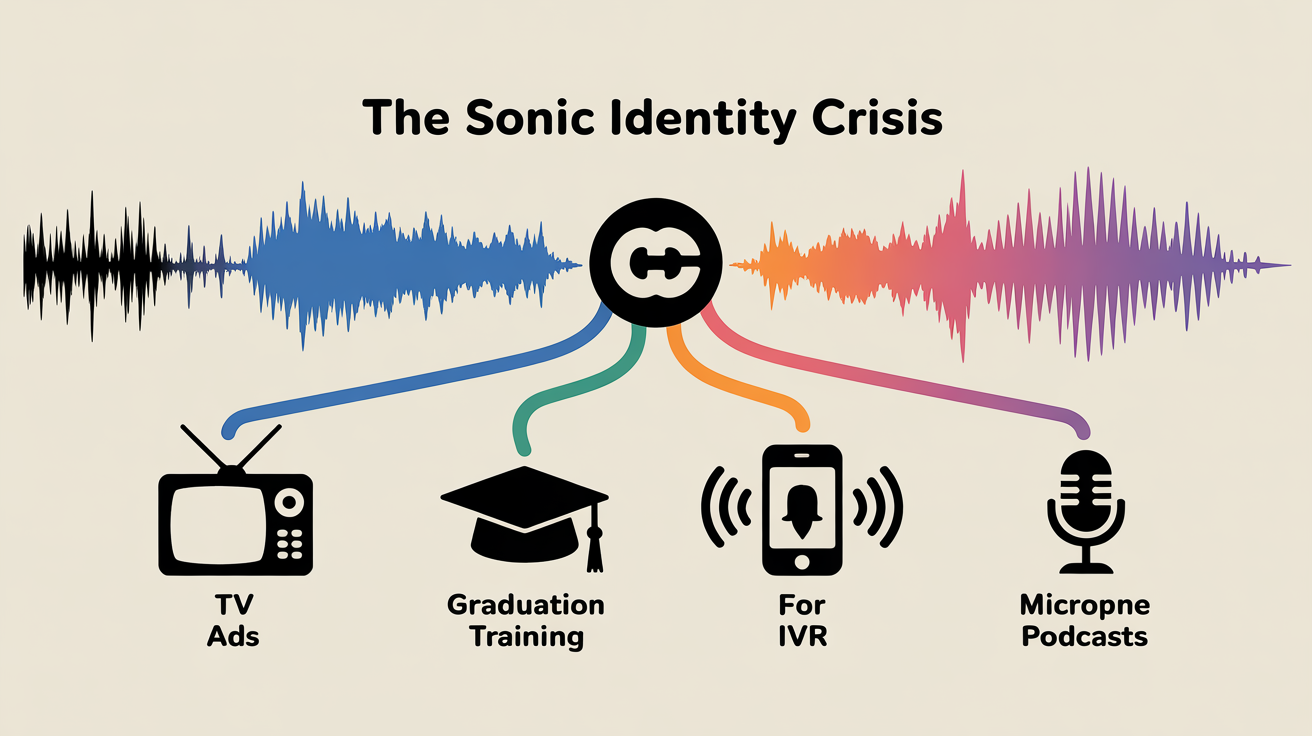 Infographic titled "The Sonic Identity Crisis" showing a central logo with four chaotic, inconsistent soundwaves leading to different business channels like ads and training.
Infographic titled "The Sonic Identity Crisis" showing a central logo with four chaotic, inconsistent soundwaves leading to different business channels like ads and training.For decades, achieving sonic consistency was a logistical nightmare of exclusive contracts with single voice actors and painstakingly managed recording sessions. Now, AI voice cloning offers a powerful solution, allowing organizations to create a "voice bank" of consistent, high-quality brand and executive voices. But this solution presents a new, high-stakes challenge: How do you manage, govern, and securely deploy these powerful assets across an entire organization?
This is not a technical problem; it is a governance problem. If anyone can use the CEO's cloned voice for a departmental presentation, or if the French marketing team can't access the official French-language brand voice, you haven't solved the chaos - you've just digitized it.
This report is a strategic guide for organizational leaders on creating a robust system for team voice management. We will dissect the strategies for building a secure "voice bank," establishing clear governance protocols, and empowering teams to collaborate on voice assets without compromising brand integrity or security.
From Asset to Anarchy: The Risk of Unmanaged Voice Clones
Without a central management strategy, the proliferation of AI voices within a company can quickly lead to anarchy.
 Cartoon illustration depicting office chaos, with employees puppeteering AI clones of their horrified CEO's head, symbolizing security risks
Cartoon illustration depicting office chaos, with employees puppeteering AI clones of their horrified CEO's head, symbolizing security risksBrand Dilution: Different departments use different AI voices—or worse, low-quality free tools—for official content, further fracturing the brand's identity.
Security Risks: An employee clones the CFO's voice to create a "funny" departmental video. While the intent may be harmless, the security implications are enormous. The unauthorized creation and use of executive voice clones is a critical threat vector.
Wasted Resources: The US marketing team and the German marketing team independently create two separate "brand voices," duplicating effort and cost, and resulting in two different sonic identities.
Compliance & Legal Perils: An employee whose voice was cloned as a "brand narrator" leaves the company. Without a proper agreement and technical controls, the company may be legally prohibited from using that voice further, forcing a costly overhaul of all existing audio content.
FROM THE TRENCHES
"The conversation has moved beyond 'Can we create an AI voice?'. The new C-level question is 'How do we control it?'. We've had clients where the marketing team in one country had no idea the L&D team in another had commissioned a nearly identical project. It's the wild west. A central 'Voice Bank' with clear user permissions isn't a feature; it's a necessity for any enterprise-level deployment."
— Statement from a leading digital transformation consultancy.
The Central Voice Bank: The Single Source of Truth for Your Sonic Brand
The solution is to treat your organization's voices with the same seriousness as your visual brand assets. Just as you have a central library for logos and brand colors, you must create a Central Voice Bank. This is a secure, cloud-based repository of all official voice clones for the organization.
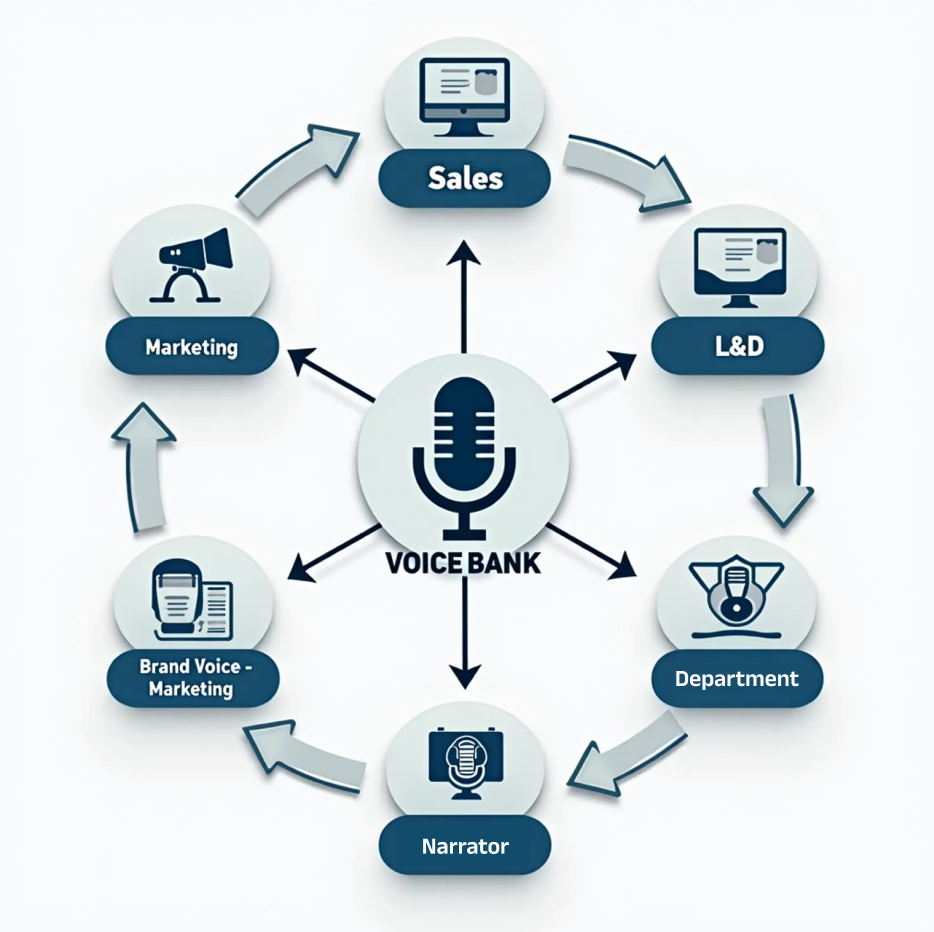 Flowchart demonstrating a central "Voice Bank" securely distributing specific, approved voice assets to Marketing, Sales, and L&D departments.
Flowchart demonstrating a central "Voice Bank" securely distributing specific, approved voice assets to Marketing, Sales, and L&D departments.Platforms like Kukarella, designed for collaboration, are essential for creating this. They provide the workspace where these assets are not just stored, but managed.
 Screenshot of Kukarella's Voice Library, showing a list of cloned brand voices
Screenshot of Kukarella's Voice Library, showing a list of cloned brand voicesThe New Playbook: Four Pillars of Enterprise Voice Management
1. Strategy: Curating the Official Voice Portfolio
The first step is strategic. You must decide which voices the organization needs. This typically includes:
The Official Brand Voice(s): A primary brand voice (e.g., warm, professional male voice) and possibly a secondary voice (e.g., energetic, friendly female voice). These are often created using professional TTS voices or by hiring and cloning a voice actor specifically for this purpose.
Executive Voice Clones: Clones of the CEO, CFO, and other key C-suite leaders for use in official internal and external communications. Crucially, this requires their enthusiastic, written consent and a clear usage agreement.
Regional & Language Variants: Multilingual clones of the primary brand voice for key international markets (e.g., "Brand Voice - German," "Brand Voice - Japanese").
Specialized Voices: A designated "eLearning Narrator" voice or a "Customer Service" voice to be used for specific departmental functions.
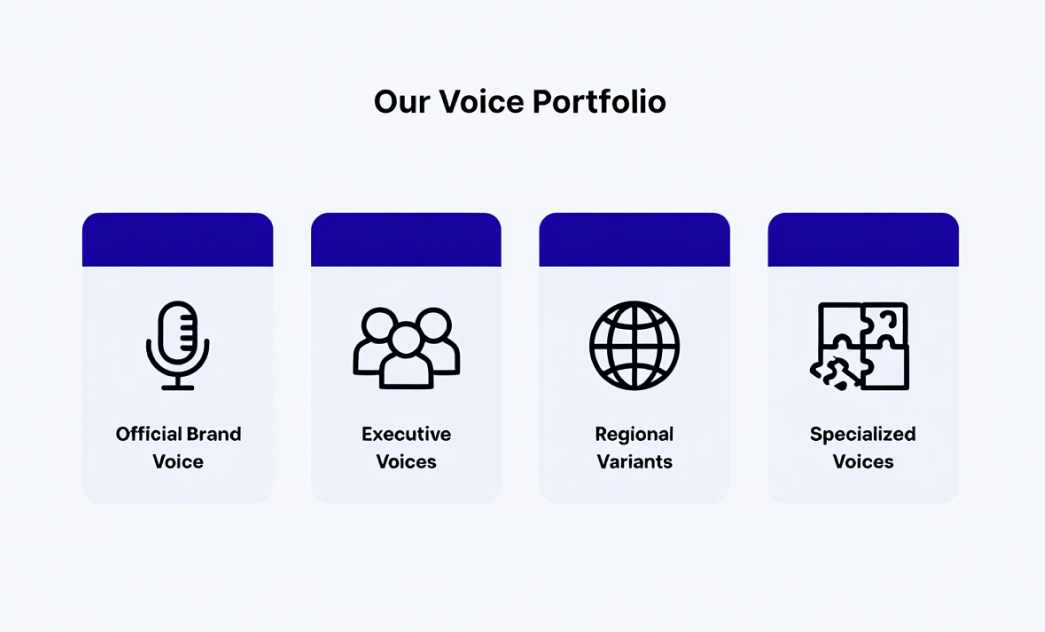 An infographic outlining a corporate "Voice Portfolio," with sections for the official brand voice, executive voices, regional variants, and specialized voices.
An infographic outlining a corporate "Voice Portfolio," with sections for the official brand voice, executive voices, regional variants, and specialized voices.2. Governance: Establishing Tiers and Permissions
This is the most critical pillar. Not everyone should have access to every voice. Your voice management platform must allow you to set up a granular permission structure.
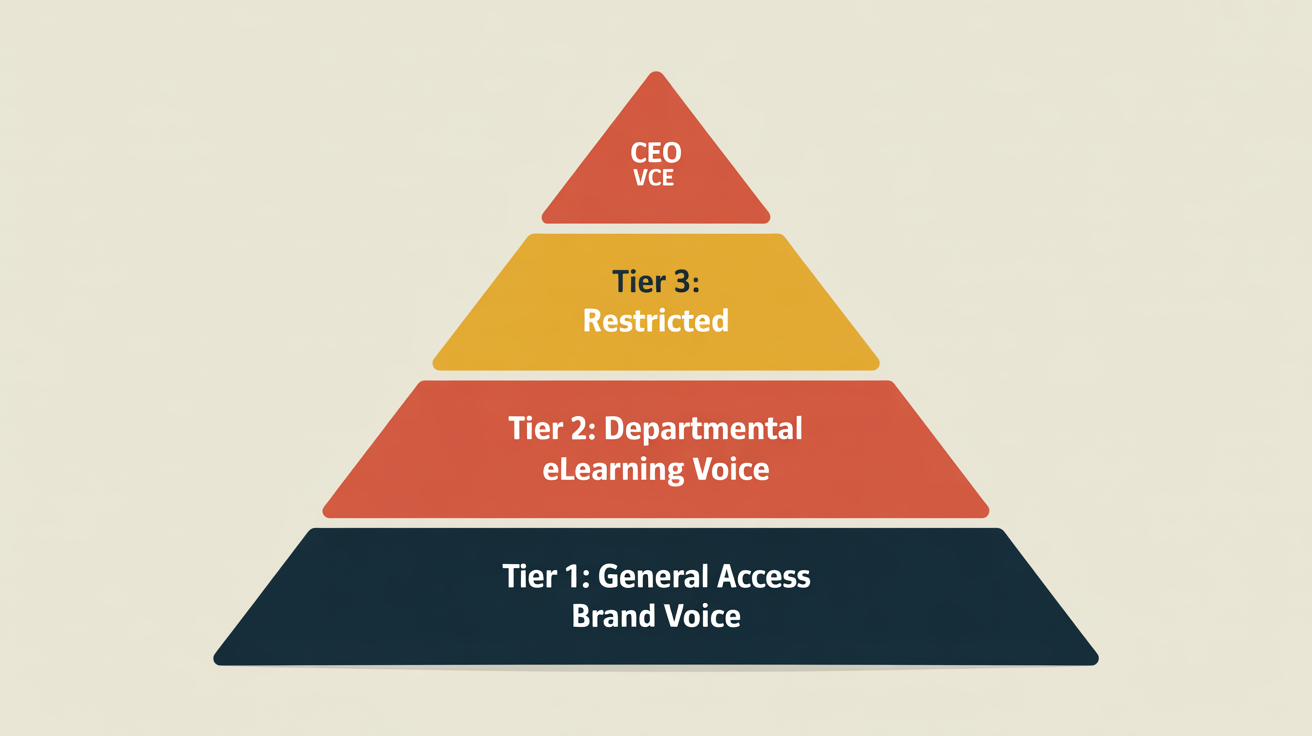 A pyramid infographic illustrating three tiers of voice clone governance, from general access at the base to restricted executive access at the top.
A pyramid infographic illustrating three tiers of voice clone governance, from general access at the base to restricted executive access at the top.Tier 1 (Public Access): The general-purpose "Brand Voice" might be accessible to all marketing and communications staff.
Tier 2 (Departmental Access): The "eLearning Narrator" voice might only be accessible to the Learning & Development team.
Tier 3 (Restricted/Executive): The CEO's voice clone should be highly restricted. Access might be granted only to the CEO's Chief of Staff or the Head of Internal Comms, with a clear protocol for requesting its use.
The Result: This tiered system prevents a junior marketing associate in a regional office from creating content with the CEO's voice. It ensures the right teams are using the right assets and provides a clear audit trail of who used which voice, and when.
3. Workflow: The Global Collaboration Model
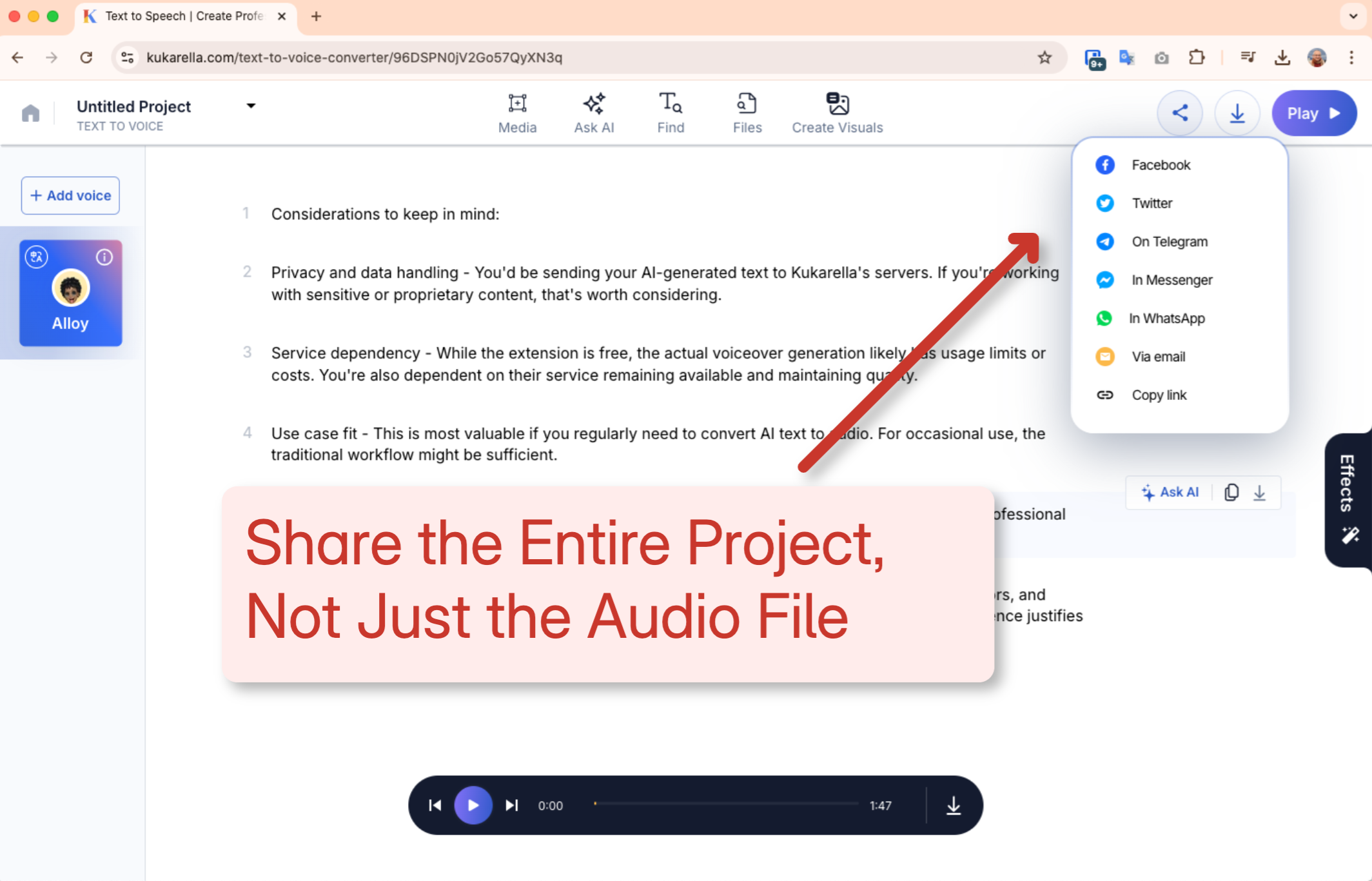 Screenshot of Kukarella's project sharing feature, demonstrating how to collaborate on a voiceover project
Screenshot of Kukarella's project sharing feature, demonstrating how to collaborate on a voiceover project
Effective management enables seamless global collaboration.
The Scenario: The global marketing team in New York creates a new product announcement script and generates the audio using the "Brand Voice - English" clone.
The Handoff: They don't just email an MP3 file to the team in France. They share the entire Kukarella project file.
The Localization: The French team opens the project. The script and timing are already there. They simply go to the voice settings, select the pre-approved "Brand Voice - French" from the shared voice bank, and click generate.
The Result: A perfectly localized version is created in minutes, maintaining the core vocal identity of the brand. The ability to share not just the audio, but the entire project environment including actors, voices, and scripts, is a massive workflow accelerator.
4. Legal & HR: The Employee Voice Agreement
 Illustration of a pen signing a contract, with the signature turning into a soundwave, symbolizing the legal agreement for voice cloning
Illustration of a pen signing a contract, with the signature turning into a soundwave, symbolizing the legal agreement for voice cloningWhat happens when an employee whose voice is a key asset leaves the company?
The "Fine Print": You must have a "Voice Asset Agreement" in place before you ever clone an employee's voice. This is a legal document, drafted by your counsel, that should clearly state:
The scope of use (e.g., for internal training materials only).
The duration of use (e.g., for as long as they are employed, plus a one-year grace period).
Buyout Clause: A potential option for the company to purchase perpetual rights to the voice clone for a specified fee upon the employee's departure.
The Technical Control: When the employee leaves, your Voice Bank administrator must be able to instantly revoke all access to that voice clone and, if required by the agreement, permanently delete the asset.
"Plot Twist" Moment: It’s Not About Control, It’s About Empowerment
The executive view of a Voice Bank is often focused on control and risk mitigation. But its most powerful, transformative effect is the empowerment of non-creative teams.
For the first time, your Head of Legal can independently create a clear, professionally-voiced audio summary of a new compliance policy without having to submit a ticket to the swamped creative department. Your engineering team lead can generate a step-by-step audio guide for a new internal tool. Your finance team can add a confident, authoritative narration to their quarterly results presentation.
The Twist: A well-managed Voice Bank democratizes communication. It removes the creative team as a bottleneck and empowers every department to create professional, on-brand audio content autonomously. The result is a massive increase in the clarity, quality, and consistency of communication across the entire organization.
Troubleshooting & Problem-Solving for Teams
Q: "We have three 'Official Brand Voices' in our Voice Bank. How do we ensure everyone uses the right one for the right project?"
A: Documentation and naming conventions are key. The voices shouldn't be named "Voice1" and "Voice2." They should have descriptive names: "BrandVoice_US_Warm_Male" or "BrandVoice_EU_Energetic_Female". Create a simple one-page style guide, pinned in your collaboration space, that states: "For all US-based marketing videos, use 'BrandVoice_US_Warm_Male'."
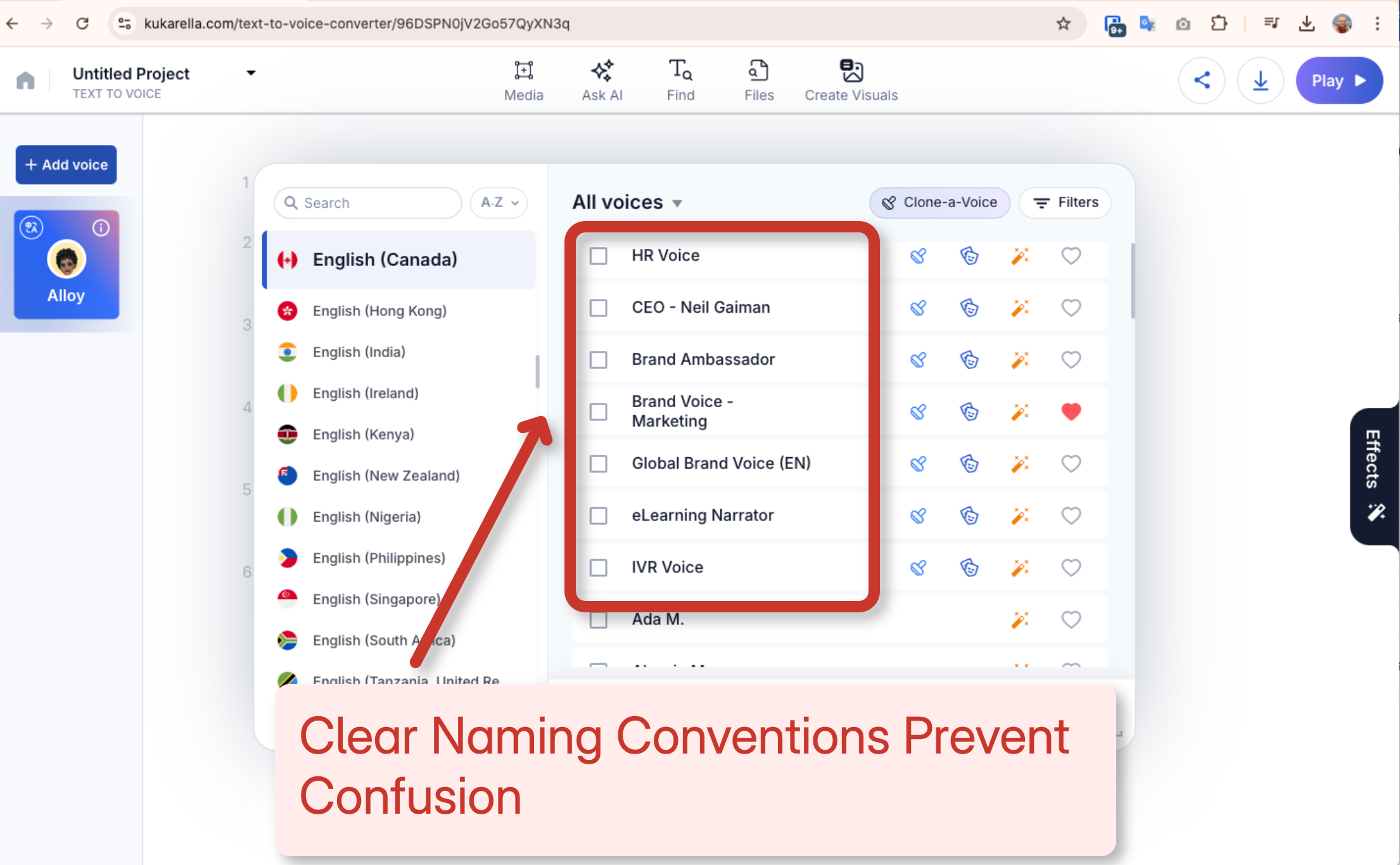 Screenshot of a Voice Bank showing clear, descriptive naming conventions for different brand voices to ensure team clarity
Screenshot of a Voice Bank showing clear, descriptive naming conventions for different brand voices to ensure team clarityQ: "A team member created a project using the wrong voice. How do we fix it without redoing the whole thing?"
A: This highlights the power of a platform like Kukarella. Because the voice is an attribute separate from the script, you don't have to start over. Simply open the project, select the actor/voice, and reassign it to the correct, approved voice from the Voice Bank. The entire project updates with the new voice in minutes.
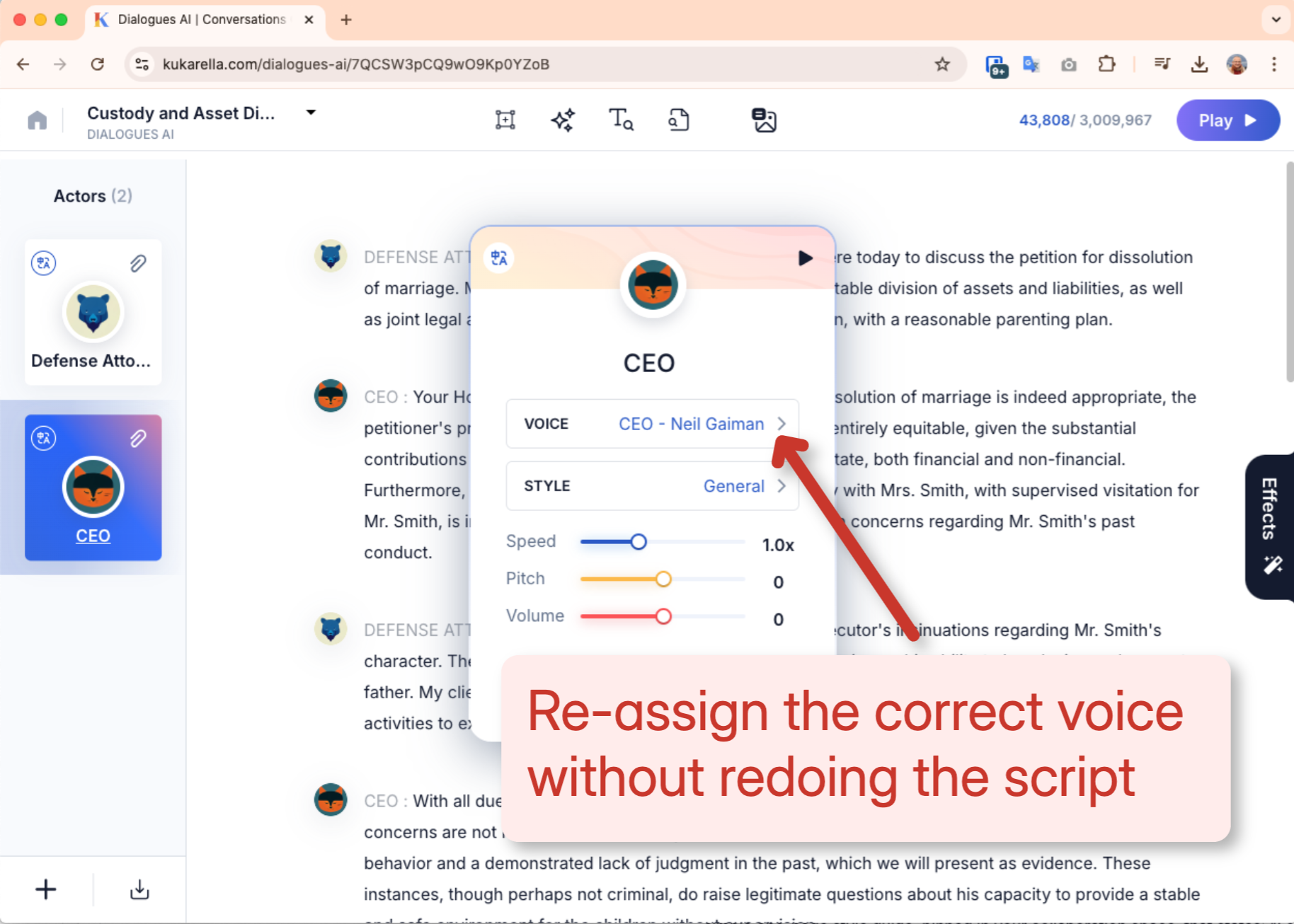 Screenshot of the Kukarella editor demonstrating how to quickly re-assign a different voice to an actor in a project
Screenshot of the Kukarella editor demonstrating how to quickly re-assign a different voice to an actor in a projectQ: "How do we handle version control for a voice clone? What if we want to update our brand voice?"
A: You treat it like software. The old clone becomes "BrandVoice_v1.0". The new clone is labeled "BrandVoice_v2.0". You can set a sunset date for v1.0, instructing all teams to use v2.0 for new projects and providing a timeline for updating key existing assets.
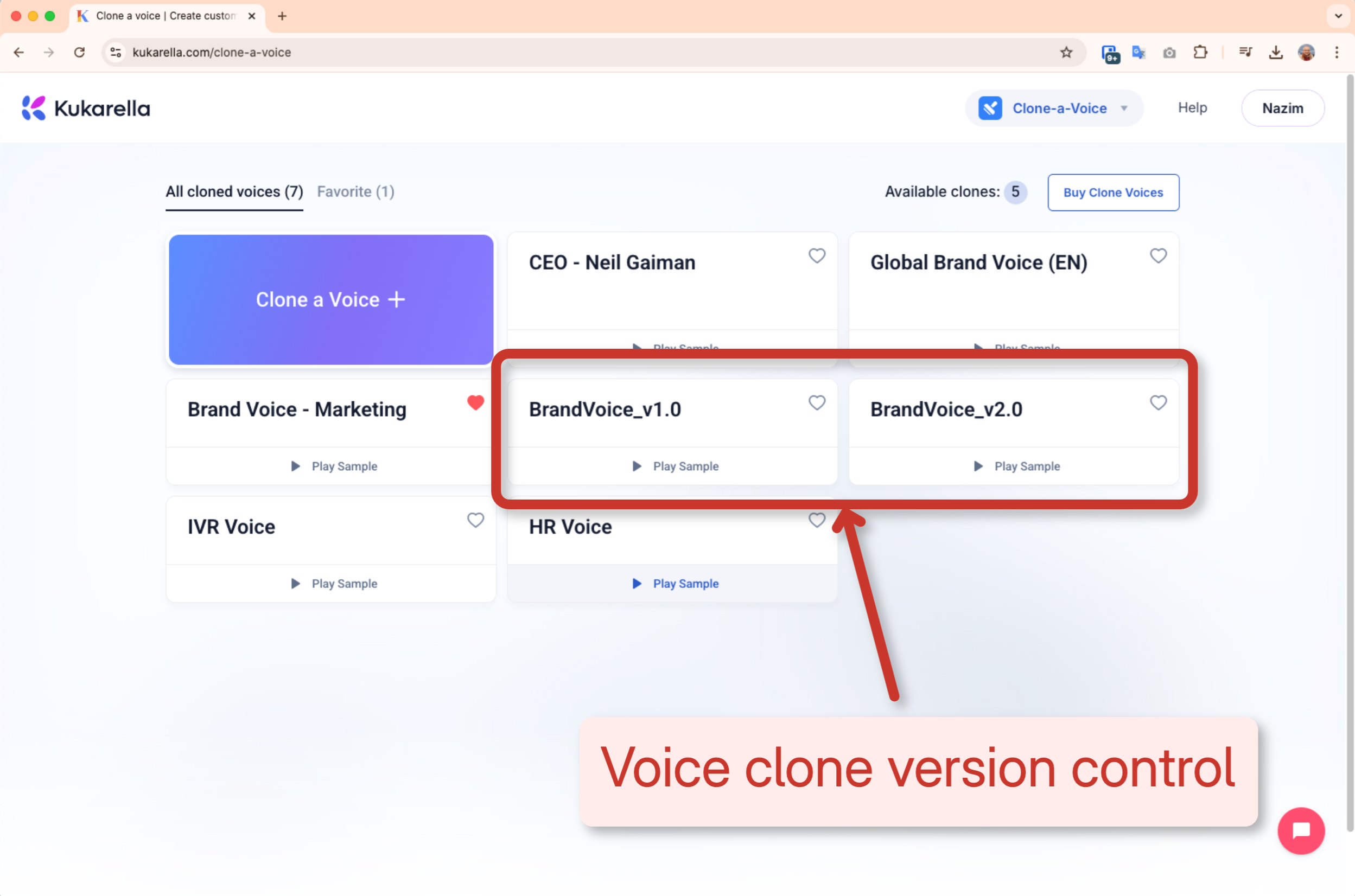 Screenshot illustrating voice clone version control, with "BrandVoice_v1.0" marked for sunset and "BrandVoice_v2.0" marked as current
Screenshot illustrating voice clone version control, with "BrandVoice_v1.0" marked for sunset and "BrandVoice_v2.0" marked as currentFrequently Asked Questions (FAQ)
Q: Does our company need a dedicated "Voice Manager"?
A: For a large enterprise, yes. Just as you have a brand manager for visual identity, having a person or small team responsible for managing the Voice Bank, setting permissions, and enforcing governance is a wise investment.
Q: How do we get started? What's the first step?
A: Start with a pilot project. Don't try to clone every executive at once. Choose one high-value use case, like creating a single, consistent brand voice for your top 5 marketing videos. Prove the value, establish the workflow, and then scale from there.
Q: Can we integrate this with our other enterprise software?
A: The future of this technology lies in API integrations. Imagine integrating your Voice Bank with your Learning Management System (LMS) or your Content Management System (CMS), allowing other applications to call on your approved brand voices programmatically.
An unmanaged voice strategy is a liability. A managed voice strategy is a powerful competitive advantage. By creating a central source of truth for your sonic identity, you're not just creating consistency; you're building a scalable platform for clearer, more effective communication across your entire global enterprise.